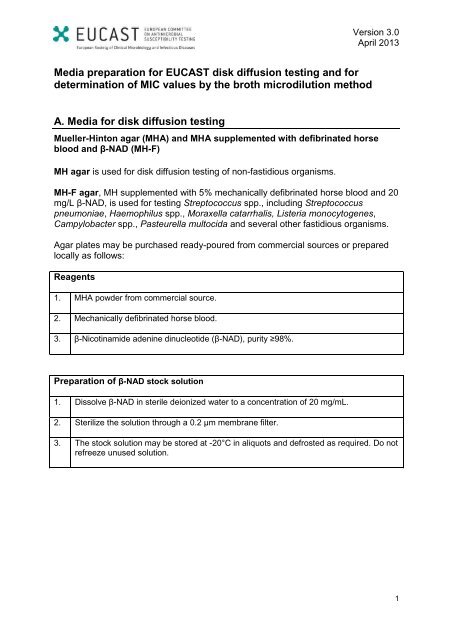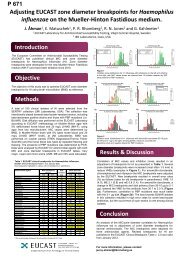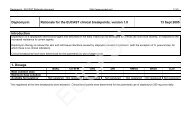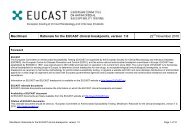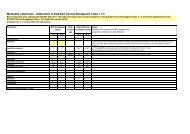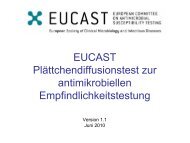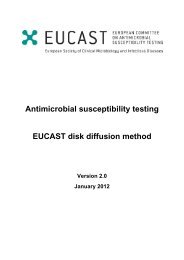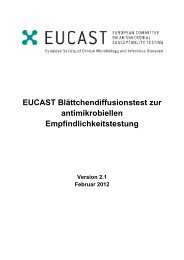Preparation of plates and broth for EUCAST AST
Preparation of plates and broth for EUCAST AST
Preparation of plates and broth for EUCAST AST
Create successful ePaper yourself
Turn your PDF publications into a flip-book with our unique Google optimized e-Paper software.
Version 3.0<br />
April 2013<br />
Media preparation <strong>for</strong> <strong>EUC<strong>AST</strong></strong> disk diffusion testing <strong>and</strong> <strong>for</strong><br />
determination <strong>of</strong> MIC values by the <strong>broth</strong> microdilution method<br />
A. Media <strong>for</strong> disk diffusion testing<br />
Mueller-Hinton agar (MHA) <strong>and</strong> MHA supplemented with defibrinated horse<br />
blood <strong>and</strong> β-NAD (MH-F)<br />
MH agar is used <strong>for</strong> disk diffusion testing <strong>of</strong> non-fastidious organisms.<br />
MH-F agar, MH supplemented with 5% mechanically defibrinated horse blood <strong>and</strong> 20<br />
mg/L β-NAD, is used <strong>for</strong> testing Streptococcus spp., including Streptococcus<br />
pneumoniae, Haemophilus spp., Moraxella catarrhalis, Listeria monocytogenes,<br />
Campylobacter spp., Pasteurella multocida <strong>and</strong> several other fastidious organisms.<br />
Agar <strong>plates</strong> may be purchased ready-poured from commercial sources or prepared<br />
locally as follows:<br />
Reagents<br />
1. MHA powder from commercial source.<br />
2. Mechanically defibrinated horse blood.<br />
3. β-Nicotinamide adenine dinucleotide (β-NAD), purity ≥98%.<br />
<strong>Preparation</strong> <strong>of</strong> β-NAD stock solution<br />
1. Dissolve β-NAD in sterile deionized water to a concentration <strong>of</strong> 20 mg/mL.<br />
2. Sterilize the solution through a 0.2 µm membrane filter.<br />
3. The stock solution may be stored at -20°C in aliquots <strong>and</strong> defrosted as required. Do not<br />
refreeze unused solution.<br />
1
Version 3.0<br />
April 2013<br />
<strong>Preparation</strong> <strong>of</strong> agar <strong>plates</strong><br />
1. Prepare <strong>and</strong> autoclave MHA according to the manufacturer’s instructions.<br />
2. Cool medium to 42-45°C.<br />
3. For MH-F, aseptically add 50 mL mechanically defibrinated horse blood <strong>and</strong> 1 mL β-<br />
NAD stock solution per litre medium. Mix well <strong>and</strong> dispense immediately.<br />
4. Dispense medium into sterile Petri dishes to give a level depth <strong>of</strong> 4 mm 0.5 mm<br />
(approximately 25 mL in a 90 mm circular plate, 31 mL in a 100 mm circular plate, 71<br />
mL in a 150 mm circular plate, 40 mL in a 100 mm square plate).<br />
5. Allow the agar to set be<strong>for</strong>e moving the <strong>plates</strong>.<br />
6. The surface <strong>of</strong> the agar should be dry be<strong>for</strong>e use. Whether <strong>plates</strong> require drying <strong>and</strong><br />
the length <strong>of</strong> time needed to dry the surface <strong>of</strong> the agar depends on storage <strong>and</strong> drying<br />
conditions. Do not over-dry <strong>plates</strong>.<br />
Storage <strong>of</strong> agar <strong>plates</strong><br />
1. Store <strong>plates</strong> in vented plastic boxes at 8-10°C. If <strong>plates</strong> are stored <strong>for</strong> longer than seven<br />
days, alternative storage, such as storing <strong>plates</strong> at 4-8°C in sealed plastic bags, may be<br />
required.<br />
2. For <strong>plates</strong> prepared in-house, plate drying, storage conditions <strong>and</strong> shelf life should be<br />
determined as part <strong>of</strong> the laboratory quality assurance programme.<br />
3. Commercially prepared <strong>plates</strong> should be stored as recommended by the manufacturer<br />
<strong>and</strong> used within the labelled expiry date.<br />
Quality control<br />
1 Use a surface pH electrode to check that the pH is within the range 7.2-7.4.<br />
2 Check that the agar depth is 4 mm 0.5 mm.<br />
3 Check that the medium supports good growth <strong>of</strong> control strain(s) <strong>of</strong> the intended test<br />
organisms.<br />
4 Check that inhibition zones are within control limits <strong>for</strong> all bacteria-antimicrobial agent<br />
combinations used.<br />
2
Version 3.0<br />
April 2013<br />
B. Media <strong>for</strong> MIC determination by the <strong>broth</strong> microdilution method<br />
Cation-adjusted Mueller-Hinton <strong>broth</strong> (MHB) <strong>and</strong> MHB supplemented with lysed<br />
horse blood <strong>and</strong> β-NAD (MH-F <strong>broth</strong>)<br />
MH <strong>broth</strong>, unsupplemented cation-adjusted Mueller-Hinton <strong>broth</strong>, is used <strong>for</strong> <strong>broth</strong><br />
microdilution testing <strong>of</strong> non-fastidious organisms according to the ISO st<strong>and</strong>ard<br />
20776-1, 2006.<br />
MH-F <strong>broth</strong>, MH <strong>broth</strong> supplemented with 5% lysed horse blood <strong>and</strong> 20 mg/L β-<br />
NAD, is used <strong>for</strong> testing Streptococcus spp., including Streptococcus pneumoniae,<br />
Haemophilus spp., Moraxella catarrhalis, Listeria monocytogenes, Campylobacter<br />
spp., Pasteurella multocida <strong>and</strong> several other fastidious organisms.<br />
MH-F <strong>broth</strong> is prepared as follows:<br />
Reagents<br />
1. Cation-adjusted MHB from commercial source.<br />
2. 50% lysed horse blood.<br />
3. β-Nicotinamide adenine dinucleotide (β-NAD), purity ≥98%.<br />
<strong>Preparation</strong> <strong>of</strong> 50% lysed horse blood stock solution<br />
1. Aseptically dilute the horse blood with an equal amount <strong>of</strong> sterile deionized water.<br />
2. Freeze the blood at -20°C overnight <strong>and</strong> thaw. Repeat the cycle until the cells are<br />
completely lysed (three cycles is usually sufficient but the ISO st<strong>and</strong>ard 20776-1<br />
suggests that up to seven cycles may be required).<br />
3. Clarify the 50% lysed horse blood by centrifugation.<br />
4. The stock solution may be stored at -20°C in aliquots <strong>and</strong> defrosted as required. Do not<br />
refreeze unused solution.<br />
3
Version 3.0<br />
April 2013<br />
<strong>Preparation</strong> <strong>of</strong> β-NAD stock solution<br />
1. Dissolve β-NAD in sterile deionized water to a concentration <strong>of</strong> 20 mg/mL.<br />
2. Sterilize the solution through a 0.2 µm membrane filter.<br />
3. The stock solution may be stored at -20°C in aliquots <strong>and</strong> defrosted as required. Do not<br />
refreeze unused solution.<br />
<strong>Preparation</strong> MH-F <strong>broth</strong><br />
1. Prepare <strong>and</strong> autoclave cation-adjusted MHB according to the manufacturer’s<br />
instructions, but with 100 mL less deionized water per litre to allow <strong>for</strong> the addition <strong>of</strong><br />
lysed horse blood.<br />
2. Cool medium to 42-45°C.<br />
3. Aseptically add 100 mL 50% lysed horse blood <strong>and</strong> 1 mL β-NAD stock solution per litre<br />
medium <strong>and</strong> mix well.<br />
4. Dispense MH-F <strong>broth</strong> in sterile containers with screw caps.<br />
Storage <strong>of</strong> MH-F <strong>broth</strong><br />
1. Store MH-F <strong>broth</strong> at 4-8°C.<br />
2. Storage conditions <strong>and</strong> shelf life should be determined as part <strong>of</strong> the laboratory quality<br />
assurance programme. A shelf life <strong>of</strong> 6 months can be expected.<br />
Quality control<br />
1 Check that the pH is within the range 7.2-7.4.<br />
2 Check that the medium supports good growth <strong>of</strong> control strain(s) <strong>of</strong> the intended test<br />
organisms.<br />
3 Check that MICs are within control limits <strong>for</strong> all bacteria-antimicrobial agent<br />
combinations used.<br />
4


